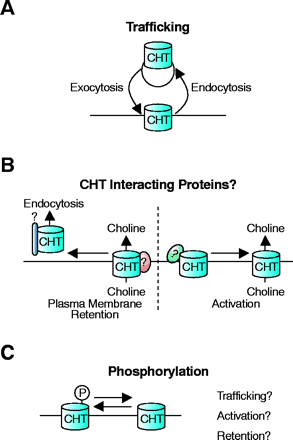
- Institution: Stanford Univ Med Ctr Lane Med Lib/Periodical Dept/Rm L109
- Sign In as Member / Individual
The Choline Transporter Resurfaces: New Roles for Synaptic Vesicles?

Potential mechanisms for the regulation of CHT function. Each of these mechanisms represents a candidate target for the pharmacological enhancement of CHT function. (A) A trafficking component is supported by the large cytoplasmic reserve of CHT on cholinergic synaptic vesicles that could serve to couple choline uptake capacity to the rate of ACh release (66). CHT abundance at the plasma membrane will reflect the balance between CHT exocytosis and endocytosis. (B) There are many possible ways to regulate CHT through interacting proteins. Different binding partners could either retain CHT at the plasma membrane or lead to CHT’s recruitment into clathrin-coated pits for endocytosis. Alternatively, the activity of CHTs within the plasma membrane could be regulated by interactions between CHT and other as yet unidentified proteins. (C) In conjunction with trafficking mechanisms and protein–protein interactions for controlling CHT function, posttranslational modification of the transporter could also serve control presynaptic choline uptake. The CHT phosphorylation state could directly regulate transport activity but might also determine the affinity of interactions between CHT and various regulatory or trafficking proteins.


